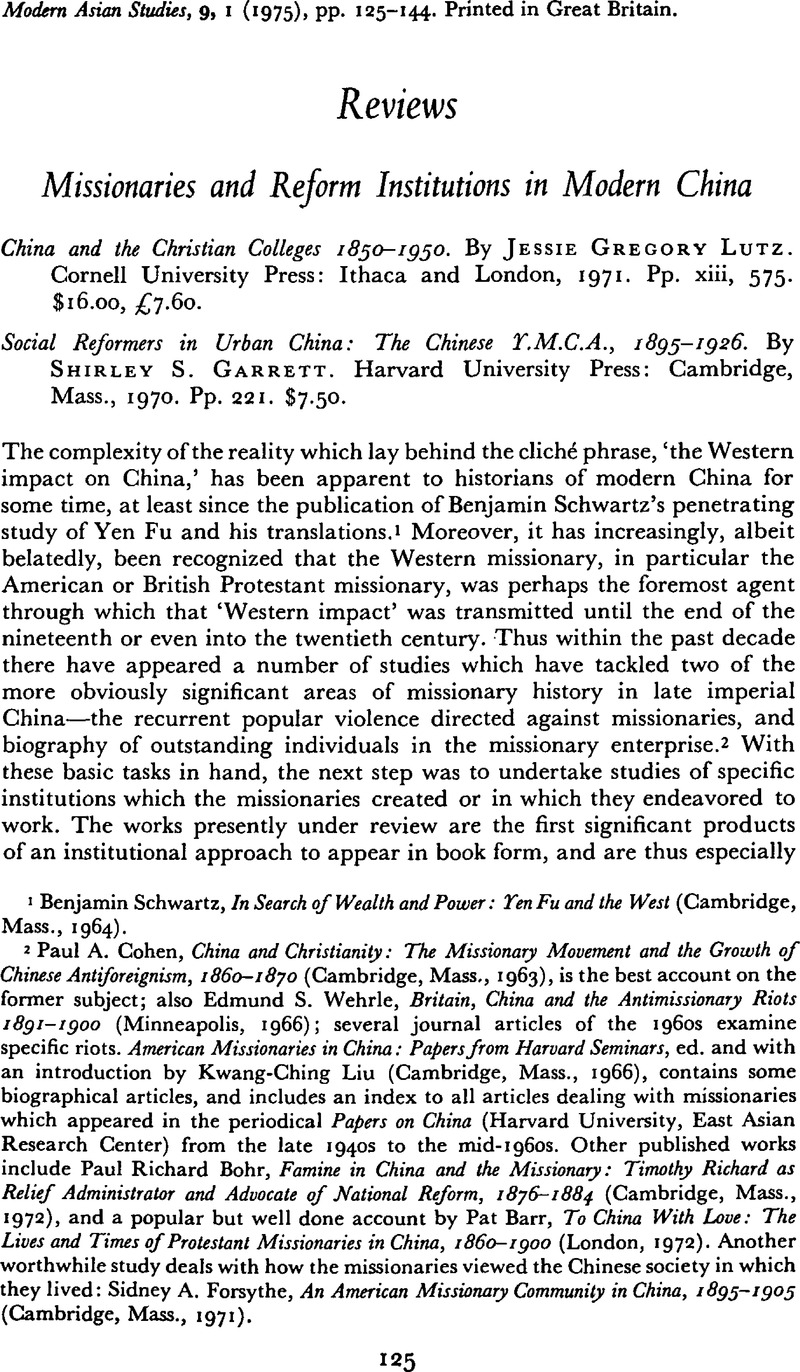No CrossRef data available.
Article contents
Missionaries and Reform Institutions in Modern China - China and the Christian Colleges 1850–1950. By Lutz Jessie Gregory. Cornell University Press: Ithaca and London, 1971. Pp. xiii, 575. $16.00, £7.60. - Social Reformers in Urban China: The Chinese Y.M.C.A., 1895–1926. By S. Garrett Shirley. Harvard University Press: Cambridge, Mass., 1970. Pp. 221. $7.50.
Published online by Cambridge University Press: 28 November 2008
Abstract

- Type
- Reviews
- Information
- Copyright
- Copyright © Cambridge University Press 1975
References
1 Benjamin, Schwartz, In Search of Wealth and Power: Yen Fu and the West (Cambridge, Mass., 1964).Google Scholar
2 Paul, A. Cohen, China and Christianity: The Missionary Movement and the Growth of Chinese Antforeignism, 1860–1870 (Cambridge, Mass., 1963),Google Scholar
is the best account on the former subject; also Edmund, S. Wehrle, Britain, China and the Antimissionary Riots 1891–1900 (Minneapolis, 1966);Google Scholar
several journal articles of the 1960s examine specific riots.Google Scholar
American Missionaries in China: Papers from Harvard Seminars, ed. and with an introduction by Kwang-Ching, Liu (Cambridge, Mass., 1966),Google Scholar
contains some biographical articles, and includes an index to all articles dealing with missionaries which appeared in the periodical Papers on China (Harvard University, East Asian Research Center) from the late 1940s to the mid-1960s.Google Scholar
Other published works include Richard, Bohr Paul, Famine in China and the Missionary: Timothy Richard as Relief Administrator and Advocate of National Reform, 1876–1884 (Cambridge, Mass., 1972),Google Scholar
and a popular but well done account by Pat, Barr, To China With Love: The Lives and Times of Protestant Missionaries in China, 1860–1900 (London, 1972).Google Scholar
Another worthwhile study deals with how the missionaries viewed the Chinese society in which they lived: Sidney, A. Forsythe, An American Missionary Community in China, 1895–1905 (Cambridge, Mass., 1971).Google Scholar
3 Short studies of specific institutions, especially schools, have appeared in Papers on China, however, and there is an introductory article by Liu, K. C., ‘Early Christian Colleges in China’, Journal of Asian Studies, 20.1 (11 1960), 71–8.CrossRefGoogle Scholar
4 My own feeling is that the conclusions in this part would prove valid, if applied to higher education as a whole. But one would first want to check some sources not used by Lutz, for example, the very rich set of materials on Chinese higher education in the 1930s and during the war with Japan, recently reproduced by the Center for Chinese Research Materials of the Association of Research Libraries in Washington, D.C.Google Scholar
1 See Clifton, Jackson Phillips, Protestant America and the Pagan World: The First Half Century of the American Board of Commissioners for Foreign Missions, 1810–1860 (Cambridge, Mass., 1969), chs 2 and 5;Google Scholar
Field, James A. Jr, America and the Mediterranean World, 1776–1882 (Princeton, 1969), chs 3, 5, 6, 8 and 10;Google Scholar
David, H. Finnie, Pioneers East: The Early American Experience in the Middle East (Cambridge, Mass., 1967);Google Scholar
Kenneth, Ingham, Reformers in India, 1793–1833: An Account of the Work of Christian Missionaries on Behalf of Social Reform (Cambridge, 1956), ch.4;Google Scholar
Potts, E. Daniel, British Baptist Missionaries in India, 1793–1837: The History of Serampore and its Missions (Cambridge, 1967), ch. 6;Google Scholar
Laird, M. A., Missionaries and Education in Bengal, 1793–1837 (Oxford, 1972). There are undoubtedly many other areas where understanding of missionary behavior and policies in China would be greatly improved by explicit comparison with earlier experience in the Ottoman Empire or India, or both.Google Scholar
6 These archives are located in Austin, Texas.Google Scholar
7 See Wang, Shu-huai, ‘Chi-tu chiao chiao-yü hui chi ch'i ch'u-pan shih-yeh’ (The Educational Association of China and its publications), Chung-yang yen-chiu-yüan chin-tai shih yen-chiu-so chi-k'an (Bulletin of the Institute of Modern History, Academia Sinica), 2(1971), 365–96. The records of the triennial meetings of this organization have recently been reprinted and are available, and frequent reports of its activities appeared in the education section of The Chinese Recorder and Missionary Journal, published in Shanghai.Google Scholar
8 For example, the mass education program and other projects described by James, Thomson Jr, in While China Faced West: American Reformers in Nationalist China, 1928–1937 (Cambridge, Mass., 1969).Google Scholar


